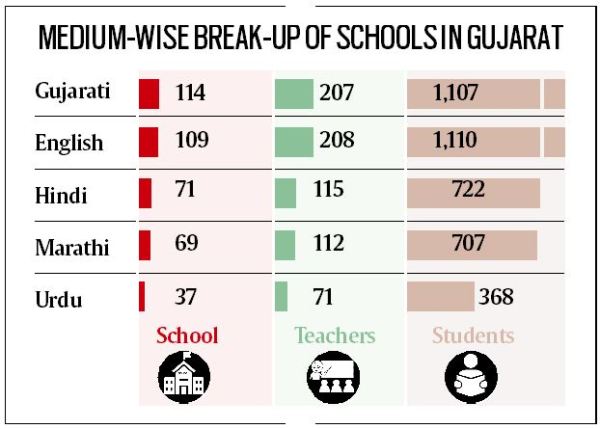3rd graders in Gujarat better in English, Hindi than Gujarati: Survey
The number of Class 3 students in the state who could listen and comprehend four to five texts of varying lengths correctly is the lowest in Gujarati—the mother tongue—and is even lower than English, Urdu, Marathi and Hindi.
In addition, only a little more than half of Class 3 students sampled in a recent survey in Gujarat could correctly identify one half of a fraction compared to the national average of 70 per cent, while a only 59 per cent could recognise and read four-digit numbers (up to 9,999) against the 64 per cent across India.
These are the findings of the Foundational Learning Study (FLS) 2022-Gujarat State Report by the National Council of Educational Research and Training (NCERT) released Wednesday.
While 59 per cent Class 3 students can read numbers up to 9,999, the number is further low when it comes to reading numbers up to 999 (21 per cent) and 99 (16 per cent).
Similarly, only 39 per cent can add numbers upto 999 against the national average of 53 per cent and only 24 per cent can subtract numbers upto 999 compared to 40 per cent nationally.


In terms of identifying and representing fractional values of half, one-fourth, three-fourth of a whole and in a collection of 12 objects, 57 per cent correctly identified one-half, while 32 per cent correctly identified one-fourth against the national average of 47 per cent.
Only 46 per cent correctly identified three-fourth compared to the national average of 61 per cent, while 28 per cent correctly identified all the fractions (one-half, one-fourth, three-fourth) against a 42 per cent national average. Nearly 25 per cent compared to 40 per cent nationally correctly represented all the given fractions.
“Forty-three per cent against a national average of 54 per cent identifies the application of operation of addition in real-life situations and provides the correct answer for questions based on addition only, 31 per cent identifies the application of operation of subtraction in real-life situations and provides the correct answer for questions based on subtraction against a national average of 42 per cent,” states the report.
In foundational literacy for English language, the report reveals that 82 per cent students were able to listen and comprehend four to five texts of varying lengths correctly against 85 per cent students nationally, while 95 per cent read 80-100 letters, and 70 per cent read 80 per cent and more words.
However, in Gujarati language, only 77 per cent were able to listen and comprehend four to five texts of varying lengths correctly, 73 per cent read 80-100 letters correctly and fluently, while 71 per cent read 80 per cent and more words.
In Hindi language, 88 per cent against a national average of 87 per cent were able to read and comprehend four to five texts of varying lengths correctly and fluently. While 83 per cent read 80-100 letters, and 74 per cent read 80 per cent and more words.
Similarly, in Marathi, 84 per cent listened and comprehended four to five texts of varying lengths against a national average of 82 per cent. While 81 per cent read 80-100 letters correctly, 71 per cent read 80 per cent and more words.
AHMEDABAD
In Urdu language too, the scores are better than mother tongue Gujarati. While 87 per cent listened and comprehended four to five texts of varying lengths against a national average of 84 per cent, 91 per cent read 80-100 letters versus 82 per cent students nationally. Nearly 72 per cent read 80 per cent and more words as opposed to the national average of 60 per cent.
FLS was undertaken by NCERT in March to strengthen the efforts towards Foundational Literacy and Numeracy (FLN) as part of the education ministry’s NIPUN (National Initiative for Proficiency in Reading with Understanding and Numeracy) Bharat to enable all Class 3 children to attain foundational skills by 2026-27.
As many as 400 schools, 713 teachers and 4,014 students from Gujarat participated in the national survey that aims to provide reliable and valid data about Class 3 students in terms of foundational literacy and numeracy and the extent of learning outcomes being achieved as well as to provide data to report on SDG (Sustainable Development Goals) 4.1.1 indicators globally.



